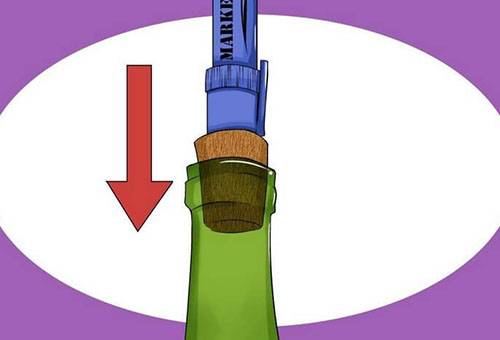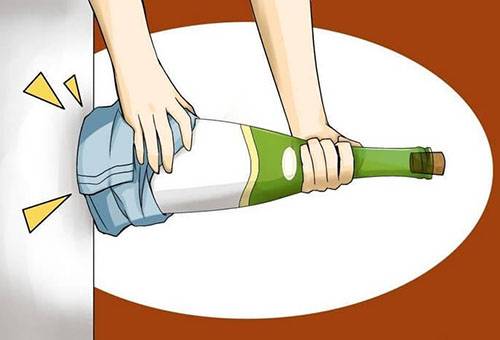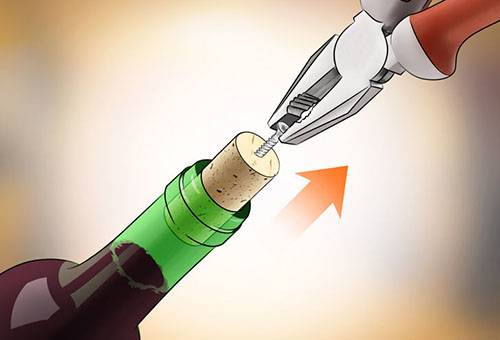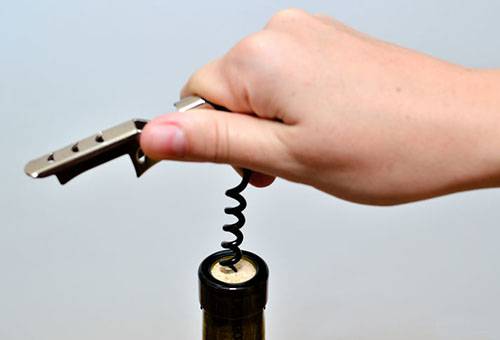Simple ways to open a wine with a corkscrew and without a corkscrew without breaking a bottle
The wonderful thing is a picnic: fresh air, delicious food, fun games, and wine were not forgotten to grab. Well, time to get a corkscrew? And how often does it happen to you that an entire company, arriving at a place, sits above a bottle in thought about how to open wine without a corkscrew? After all, here the task is akin to the work of a sapper: one wrong move - and instead of fun you will get a broken bottle, a quarrel with reproaches and destroyed plans for a sortie.
The best ways to open wine without a corkscrew
If the nearest store is far away and it is not possible to buy the simplest cheap corkscrew, you will have to do it yourself, improvised means and, of course, ingenuity. Let's say right away: it is better to start opening wine without a corkscrew at home after you make sure that the neighbors are not ready to lend it to you for a couple of minutes, because in such an initiative there is always a risk of breaking a bottle or pouring wine.
- Pushing the cork.
The first method worth trying out will require you to be strong and sensitive to a wine bottle at the same time. The point is, instead of pulling the cork out with a corkscrew, pushing it in, and how you will do it, is not so important. Experienced may well open the bottle even with your finger, without using any additional devices, although this greatly depends on how tightly the cork sits in the neck. People who do not have strong power should use, for example, a marker, hairpin or lipstick if the case is strong enough. You can even use a stick: the main thing is that it is clean, because when you push the cork, it can accidentally fall into the wine or bring crumbled bark and earth into it.
Tip
It is better not to carry out such manipulations on weight, while the plug will be correctly pressed slowly and carefully, and not be driven in: this will reduce the risk of a dropped bottom.
- Knocking out the cork.
To knock a cork out of a bottle, you need to have patience and a sense of proportion: if you try to open the wine in this way in a couple of strokes, then the case may end with a broken bottle and wounds. Do not forget that you are dealing with glass! So, you can knock out a cork horizontally, for example, against a wall or a tree trunk, or vertically upside down, holding a bottle between your knees.
The second option is more suitable for the first two or three strokes, otherwise you can skip the moment of uncorking the bottle and pour all the wine on the floor. Here you can hit with the palm of your hand, but the relatively heavy rubber sole of a sneaker or sneaker is just perfect. Just don't overdo it. Catch the moment when the cork comes out to a sufficient length, and pull it out by hand.
The first method is better not to use without props: you just need something to soften the blow and keep the bottle intact. It’s best to look like a pillow made of any fabric that you can find. Just in case the experiment fails, let it not be your favorite T-shirt or jeans in which you still have to go home.
Tip
And pushing and knocking the cork out is clearly not one minute. To properly uncork a bottle in these ways, you need to act slowly and carefully, as any sudden impact can leave you with a handful of wet glass in your hands.
- The means at hand.
The first two methods seem too slow for you, and you would like to know how to open a bottle of wine without a corkscrew faster? Well, there are plenty of options, but this is only in case you have at least some improvised means and tools to replace the corkscrew.
A screw and pliers can replace a primitive corkscrew: just screw in the screw and pull out the cork by pulling with pliers. The main thing here is that the cork does not crumble, otherwise the fine dust will fall into the wine, you just have to press the cork, especially if the hole was through. The use of nails will give a similar effect: if 4-5 pieces are hammered into the cork, and then pulling on them with the forked side of the hammer, then the cork will come out. Just hammer the nails carefully! Well, in theory, using the same principle, you can use a knife or scissors, although these tools are not so good at our task, like screws or nails.
Even at home, you can pull out the cork with hot water: after the bottle has been laid for a while in a container of hot water, the cork will come out practically without problems. But here there is a risk that the bottle will burst, besides the wine will be warm and tasteless.
Tip
If you decide to open the bottle in a hussar's way - that is, beat off the neck with a knife - be prepared to say goodbye to wine. Even if luck smiles at you, and the bottle does not break completely, small glass fragments in the drink with this method of uncorking are simply guaranteed.
If a corkscrew is still found
Surprisingly, the presence of a corkscrew does not always guarantee a smooth opening of the bottle, although it seems that you can’t imagine a simpler thing. Opening the bottle correctly with a corkscrew is really easy!
After cutting the foil from the neck, place the corkscrew so that the side levers look down. Now screw the drill until a couple of turns remain, and the levers do not rise up. Gentle pressure on the levers - and the wine is open! With the usual corkscrew without a lever mechanism, you will have to make a little physical effort, but the cork will give in, even if you do not have a weightlifting category.
Tip
It is possible to store wine after opening, but, of course, this will affect its taste. Young red wines will carry the best storage: in a tightly closed transparent container in the refrigerator, they can be stored safely for a couple of weeks.
Having forgotten the corkscrew, you still have a chance to enjoy the purchased wine if you use one of our tips on how to open the bottle using improvised means.



